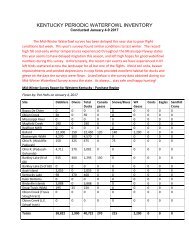Kentucky Fishes
kyfishid[1]
kyfishid[1]
- No tags were found...
You also want an ePaper? Increase the reach of your titles
YUMPU automatically turns print PDFs into web optimized ePapers that Google loves.
Freshwater Eel Family (Anguillidae)<br />
The American Eel is the only representative of this family in North America.<br />
This distinctive member of <strong>Kentucky</strong>’s fish fauna spawns in the Atlantic Ocean.<br />
Young eels travel great distances through the Gulf of Mexico to reach freshwaters of<br />
the Mississippi basin, including the Ohio River and its tributaries, where they mature.<br />
American Eel populations have declined in recent years mostly because of dams<br />
that block natural migrations.<br />
SKIPJACK HERRING<br />
(Alosa chrysochloris)<br />
Uland Thomas / North American Native <strong>Fishes</strong> Association<br />
Ç Identification: A silvery fish with a slender body that is thin from side to side and<br />
not as deep as the Threadfin and Gizzard shads (see below). It has a lower jaw that<br />
projects beyond the snout and lacks a dark spot behind the gill cover. Adults grow<br />
to 21 in.<br />
Distribution and Habitat: Occurs statewide, but primarily in main channels of the<br />
Mississippi and Ohio Rivers and lower reaches of major tributaries. Skipjacks also<br />
occur in main channels of large reservoirs and often aggregate in strong current of<br />
tailwaters.<br />
AMERICAN EEL (Anguilla rostrata)<br />
Ç Identification: The American Eel is easily distinguished by its long, snake-like<br />
body and head, long dorsal fin that is continuous with the caudal fin, and having no<br />
pelvic fins. Adults grow to about 5 ft.<br />
Distribution and Habitat: Occurs sporadically in large rivers and reservoirs statewide.<br />
Eels are seldom seen due to their habit of hiding among debris along bottoms<br />
of deep pools and channels.<br />
Herring and Shad Family (Clupeidae)<br />
John MacGregor / Ky. Dept. of Fish & Wildlife Resources<br />
<strong>Kentucky</strong> is home to three species of shad and two species of herring, including the<br />
Alewife, a native of the Atlantic Coast that has been introduced in reservoirs as a<br />
forage fish. Herrings and shads are easily recognized by their silvery, slab-sided bodies<br />
and saw-toothed keel along the midline of the belly. They generally swim in large<br />
schools and constitute an important forage base for larger sport fishes. Two of the most<br />
common species and one that has been widely introduced are presented here.<br />
GIZZARD SHAD<br />
(Dorosoma cepedianum)<br />
Å Identification: The<br />
Gizzard Shad has a<br />
long, whip-like last<br />
dorsal fin ray, rounded<br />
snout, and dark spot<br />
behind gill cover in<br />
young and small adults.<br />
Adults grow to 20 in.<br />
Distribution and<br />
Matthew Thomas / Ky. Dept. of Fish & Wildlife Resources Habitat: Common<br />
statewide, inhabiting virtually all river and reservoir habitats, but usually avoids<br />
small creeks. The Gizzard Shad feeds on plankton and is often seen in schools in<br />
deep open water near the surface.<br />
Æ Identification:<br />
Similar to the<br />
Gizzard Shad,<br />
but reaches a<br />
smaller adult<br />
size, has a<br />
protruding lower<br />
jaw, and yellowtinted<br />
fins. Adults<br />
grow to 9 in.<br />
THREADFIN SHAD (Dorosoma petenense)<br />
Matthew Thomas / Ky. Dept. of Fish & Wildlife Resources<br />
Distribution and Habitat: Open waters of larger rivers statewide, but also introduced<br />
into reservoirs throughout the state as a forage fish. Like Gizzard Shad, this species<br />
is a schooling plankton feeder; however it is less tolerant of cold water, which often<br />
results in large winter die-offs.<br />
10 11



